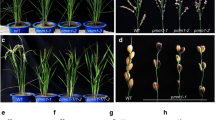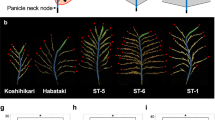Abstract
We have characterized three panicle phytomer 1 (pap1) mutations from the phytomer viewpoint. In pap1 mutants, rachis phytomers were strongly affected involving a severe reduction of rachis internode length and an increase in the number of rachis internodes (number of phytomers), resulting in a large number of primary branches. In addition, bracts were frequently over-developed. By contrast, pap1 differently affected primary branch phytomers resulting in a reduction in both the number and length of internodes. Spikelets were also modified. Rudimentary and empty glumes were frequently elongated. Floral organs were mostly normal. However, a double mutation between pap1 and fon1 markedly increased the number of floral organs compared with the single fon1 mutation, suggesting that PAP1 has a distinct role in the differentiation of floral organs. The functions of PAP1 on panicle architecture are: (1) the negative regulation of the number of phytomers on the rachis but a positive regulation of the number on primary branches, (2) an elongation of internodes, and (3) the negative regulation of bract development.
Similar content being viewed by others
Author information
Authors and Affiliations
Additional information
Received: 5 October 1997 / Accepted: 27 January 1998
Rights and permissions
About this article
Cite this article
Takahashi, M., Nagasawa, N., Kitano, H. et al. panicle phytomer 1 mutations affect the panicle architecture of rice. Theor Appl Genet 96, 1050–1056 (1998). https://doi.org/10.1007/s001220050838
Issue Date:
DOI: https://doi.org/10.1007/s001220050838




